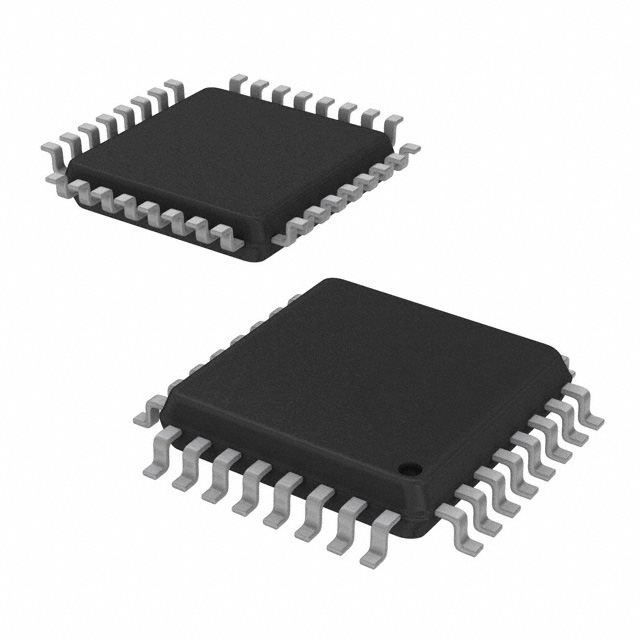Viz Specifikace pro podrobnosti o produktu.

EFM8LB10F16E-B-QFP32
Product Overview
Category
The EFM8LB10F16E-B-QFP32 belongs to the category of microcontrollers.
Use
This microcontroller is commonly used in various electronic devices and systems for controlling and processing data.
Characteristics
- High-performance 8-bit microcontroller
- Low power consumption
- Small form factor
- Integrated peripherals for enhanced functionality
Package
The EFM8LB10F16E-B-QFP32 is packaged in a Quad Flat Package (QFP) with 32 pins.
Essence
The essence of this microcontroller lies in its ability to provide efficient control and processing capabilities in a compact package.
Packaging/Quantity
The EFM8LB10F16E-B-QFP32 is typically sold in reels or trays, with a quantity of 250 units per reel/tray.
Specifications
- Architecture: 8-bit
- Flash Memory: 16 KB
- RAM: 1.5 KB
- Operating Voltage: 2.7V - 3.6V
- Clock Speed: Up to 50 MHz
- Number of Pins: 32
- Communication Interfaces: UART, SPI, I2C
- Analog-to-Digital Converter (ADC): 12-bit, 8 channels
- Timers/Counters: 4 x 16-bit, 1 x 24-bit
- Operating Temperature Range: -40°C to +85°C
Detailed Pin Configuration
The EFM8LB10F16E-B-QFP32 has a total of 32 pins, each serving a specific purpose. The pin configuration is as follows:
- P0.0 - GPIO
- P0.1 - GPIO
- P0.2 - GPIO
- P0.3 - GPIO
- P0.4 - GPIO
- P0.5 - GPIO
- P0.6 - GPIO
- P0.7 - GPIO
- P1.0 - GPIO
- P1.1 - GPIO
- P1.2 - GPIO
- P1.3 - GPIO
- P1.4 - GPIO
- P1.5 - GPIO
- P1.6 - GPIO
- P1.7 - GPIO
- P2.0 - GPIO
- P2.1 - GPIO
- P2.2 - GPIO
- P2.3 - GPIO
- P2.4 - GPIO
- P2.5 - GPIO
- P2.6 - GPIO
- P2.7 - GPIO
- RESET - Reset Pin
- VDD - Power Supply
- GND - Ground
- XTAL1 - Crystal Oscillator Input
- XTAL2 - Crystal Oscillator Output
- PWRDN - Power Down Pin
- RSTOUT - Reset Output
- VREF - Voltage Reference
Functional Features
The EFM8LB10F16E-B-QFP32 offers several functional features, including:
- High-performance 8-bit processing capabilities
- Low power consumption for energy-efficient operation
- Integrated peripherals such as UART, SPI, and I2C for communication
- Analog-to-Digital Converter (ADC) for precise analog signal measurement
- Timers/Counters for accurate timing and event counting
Advantages and Disadvantages
Advantages
- Compact form factor enables integration into space-constrained designs
- Low power consumption extends battery life in portable devices
- Versatile communication interfaces facilitate connectivity with other components
- Integrated peripherals reduce the need for external components, saving cost and board space
Disadvantages
- Limited processing power compared to higher-bit microcontrollers
- Smaller memory capacity may restrict the complexity of applications
- Limited number of I/O pins may limit the connectivity options in larger systems
Working Principles
The EFM8LB10F16E-B-QFP32 operates based on an 8-bit architecture. It executes instructions stored in its flash memory, utilizing its integrated peripherals and resources to perform various tasks. The microcontroller communicates with external devices through its communication interfaces and interacts with the environment through its I/O pins.
Detailed Application Field Plans
The EFM8LB10F16E-B-QFP32 finds application in various fields, including:
- Internet of Things (IoT) devices
- Home automation systems
- Industrial control systems
- Consumer electronics
- Automotive electronics
- Medical devices
- Robotics
Detailed and Complete Alternative Models
- EFM8LB11F16E-B-QFP32: Similar to EFM8LB10F16E-B-Q
Seznam 10 běžných otázek a odpovědí souvisejících s aplikací EFM8LB10F16E-B-QFP32 v technických řešeních
Sure! Here are 10 common questions and answers related to the application of EFM8LB10F16E-B-QFP32 in technical solutions:
Q: What is the EFM8LB10F16E-B-QFP32 microcontroller used for? A: The EFM8LB10F16E-B-QFP32 microcontroller is commonly used in various technical solutions, including industrial automation, consumer electronics, and Internet of Things (IoT) applications.
Q: What is the maximum clock frequency supported by the EFM8LB10F16E-B-QFP32? A: The EFM8LB10F16E-B-QFP32 microcontroller supports a maximum clock frequency of 50 MHz.
Q: How many I/O pins does the EFM8LB10F16E-B-QFP32 have? A: The EFM8LB10F16E-B-QFP32 has a total of 32 I/O pins.
Q: Can the EFM8LB10F16E-B-QFP32 be programmed using C language? A: Yes, the EFM8LB10F16E-B-QFP32 can be programmed using the C programming language, along with the Silicon Labs' Integrated Development Environment (IDE).
Q: Does the EFM8LB10F16E-B-QFP32 support analog-to-digital conversion (ADC)? A: Yes, the EFM8LB10F16E-B-QFP32 features an integrated 12-bit ADC module, allowing for analog signal measurements.
Q: What is the flash memory size of the EFM8LB10F16E-B-QFP32? A: The EFM8LB10F16E-B-QFP32 microcontroller has a flash memory size of 16 KB.
Q: Can the EFM8LB10F16E-B-QFP32 communicate using serial protocols like UART, SPI, and I2C? A: Yes, the EFM8LB10F16E-B-QFP32 supports multiple serial communication protocols, including UART, SPI, and I2C.
Q: Does the EFM8LB10F16E-B-QFP32 have any built-in hardware timers? A: Yes, the EFM8LB10F16E-B-QFP32 has several built-in hardware timers, which can be used for precise timing and event generation.
Q: What is the operating voltage range of the EFM8LB10F16E-B-QFP32? A: The EFM8LB10F16E-B-QFP32 operates within a voltage range of 1.8V to 3.6V.
Q: Is the EFM8LB10F16E-B-QFP32 suitable for low-power applications? A: Yes, the EFM8LB10F16E-B-QFP32 is designed with low-power features, making it suitable for battery-powered or energy-efficient applications.
Please note that these answers are general and may vary depending on specific application requirements and configurations.

